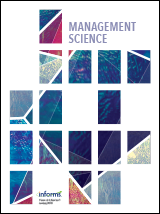Academic articles
Practitioner articles
Working papers
Books
Book chapters
Case studies
Other publications
Subject(s)
Diversity and inclusion; Ethics and social responsibility
Keyword(s)
Course design and delivery, Women in higher education, Feature article, Europe
JEL Code(s)
124
Subject(s)
Human resources management/organizational behavior; Information technology and systems; Strategy and general management; Technology, R&D management
Keyword(s)
artificial intelligence, algorithmic management, management, crowd science, citizen science, organization of science
Volume
53
Journal Pages
104985
Subject(s)
Economics, politics and business environment; Information technology and systems; Technology, R&D management
Keyword(s)
fiber optic technology, state aid, ex-post evaluation, efficiency, OECD countries
JEL Code(s)
C51, C54, H25, L52, O38
Volume
33
Journal Pages
672–700
Subject(s)
Human resources management/organizational behavior
Keyword(s)
network ecology; networking styles; academic collaboration; multiplex networks; sociology of knowledge
Volume
77
Journal Pages
166–179
ISSN (Online)
1879-2111
ISSN (Print)
0378-8733
Subject(s)
Economics, politics and business environment
Keyword(s)
strategic decisions, M&A China-Europe, hidden champions, industrial markets, entering markets abroad, managing premium products and no-frills products in one corporation
In 2013, Trumpf, a global market leader machine tools from Germany, acquired the majority shares in JFY, a smaller machine tool manufacturer from China. With this acquisition, Trumpf wanted to enter the fast-growing low-cost segment of the market. Until then, JFY had performed very well on the Chinese market, but the company's success increasingly waned after the acquistion. Other Chinese competitors performed significantly better. After JFY even had to report losses for the first time in 2019, Trumpf changed the management at JFY. Under the new management, initial successes were achieved, but even two and a half years later, JFY still did not reach the profit targets which all business units at Trumpf had to meet. In a Trumpf management meeting in October 2022, a decision was therefore to be made as to whether JFY should remain part of Trumpf or be sold off again.
| buy now | buy now | buy now |
Subject(s)
Diversity and inclusion; Health and environment; Technology, R&D management
Keyword(s)
open Innovation in Science (OIS), open science, citizen science, crowd science, crowd paradigms
Volume
9
Journal Pages
1–12
ISSN (Online)
2057-4991
Subject(s)
Strategy and general management; Technology, R&D management
Keyword(s)
novelty, innovation, selection, simmelian strangers, secondments
Volume
45
Journal Pages
716–744
Subject(s)
Human resources management/organizational behavior
Keyword(s)
leadership, leadership transitions, career transitions
ISSN (Print)
0015-6914
Subject(s)
Health and environment; Information technology and systems; Technology, R&D management
Keyword(s)
crowd science, citizen science, crowdsourcing, organizational design, research productivity, societal impact, research policy
Secondary Title
Oxford Research Encyclopedias: Business and Management
ISBN (Online)
9780190224851
Subject(s)
Management sciences, decision sciences and quantitative methods
Keyword(s)
reproducibility, replication, crowd science
With the help of more than 700 reviewers, we assess the reproducibility of nearly 500 articles published in the journal Management Science before and after the introduction of a new Data and Code Disclosure policy in 2019. When considering only articles for which data accessibility and hardware and software requirements were not an obstacle for reviewers, the results of more than 95% of articles under the new disclosure policy could be fully or largely computationally reproduced. However, for 29% of articles, at least part of the data set was not accessible to the reviewer. Considering all articles in our sample reduces the share of reproduced articles to 68%. These figures represent a significant increase compared with the period before the introduction of the disclosure policy, where only 12% of articles voluntarily provided replication materials, of which 55% could be (largely) reproduced. Substantial heterogeneity in reproducibility rates across different fields is mainly driven by differences in data set accessibility. Other reasons for unsuccessful reproduction attempts include missing code, unresolvable code errors, weak or missing documentation, and software and hardware requirements and code complexity. Our findings highlight the importance of journal code and data disclosure policies and suggest potential avenues for enhancing their effectiveness.
© 2024, INFORMS
Volume
70
Journal Pages
1343–1356
ISSN (Online)
1526-5501
ISSN (Print)
0025–1909

